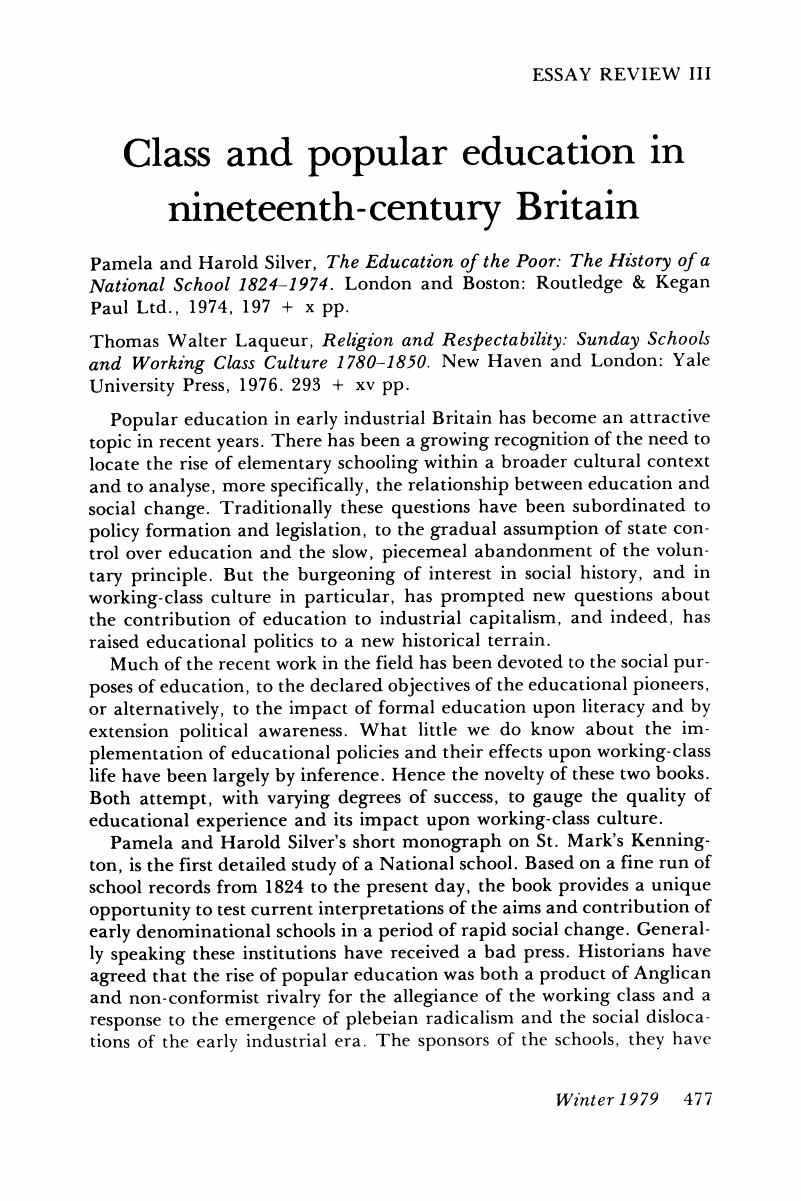No CrossRef data available.
Published online by Cambridge University Press: 24 February 2017

1 Wardle, David, English Popular Education 1780–1970 (Cambridge, 1970), p. 87.Google Scholar
2 Pamela, and Silver, Harold, The Education of the Poor: The History of A National School 1824–1974 (London, 1974), pp. 30, 46.Google Scholar
3 Silver, Harold, “Aspects of Neglect: The Strange Case of Victorian Popular Education,” Oxford Review of Education, 3, No. 1 (1977): 58.CrossRefGoogle Scholar
4 Pamela, and Silver, Harold, The Education of the Poor, pp. 115–9, 159–61.Google Scholar
5 Ibid., pp. 87–99.Google Scholar
6 “On the State of Education in Westminster,” Journal Statistical Society of London, 1 (December 1838): 454.Google Scholar
7 Laqueur, Thomas Walter, Religion and Respectability: Sunday Schools and Working Class culture 1780–1850 (New Haven and London, 1976), p. 165.Google Scholar
8 Ibid., pp. 29–31, 33, 252–4. Laqueur has located 40 working-class foundations in the period 1780–1812. By the second decade of the nineteenth century there were approximately 7,000 Sunday schools.Google Scholar
9 McClatchey, Diana, Oxfordshire Clergy 1777–1869 (Oxford, 1960), pp. 148–9. Laqueur himself admits that half the Anglican schools in London were under the direct supervision of the clergy, Religion, Respectability, p. 77.Google Scholar
10 Laqueur, Thomas W., Religion and Respectability, pp. 63–94; see also p. 189.Google Scholar
11 Parliamentary Papers, xc (1852–3), p. 73; see also Bradley, Ian, The Call to Seriousness: The Evangelical Impact on the Victorians (London, 1976), p. 123.Google Scholar
12 Wardle, David, English Popular Education, p. 62.Google Scholar
13 Parliamentary Papers, xc (1852–3), pp. 71–5.Google Scholar
14 Foster, John, Class Struggle and the Industrial Revolution (London, 1974), pp. 223–8.Google Scholar
15 Levy, Philip C., “A Nobler Humanity: A Study of the Influence of Poverty and Community on the Self-Education of Working Class Men Born in Britain between 1780 and 1850” (Ph.D. Diss., York University, Toronto, 1976), pp. 108–168, 208–44.Google Scholar
16 The Northern Star, 6 May 1843, p. 4.Google Scholar
17 Simon, Brian, Studies in the History of Education 1780–1870 (London, 1960), p. 242.Google Scholar
18 Thompson, E.P., The Making of the English Working Class (London, Penguin, 1968), pp. 457–68; Yeo, Eileen, “Robert Owen and Radical Culture,” in Pollard, Sidney and Salt, John (eds.), Robert Owen. Prophet of the Poor (London, 1971), pp. 84–114.Google Scholar
19 Laqueur, Thomas W., Religion and Respectability, p. 224.Google Scholar
20 Ibid., p. 170.Google Scholar
21 Parliamentary Papers, xc (1852–3), p. 74.Google Scholar